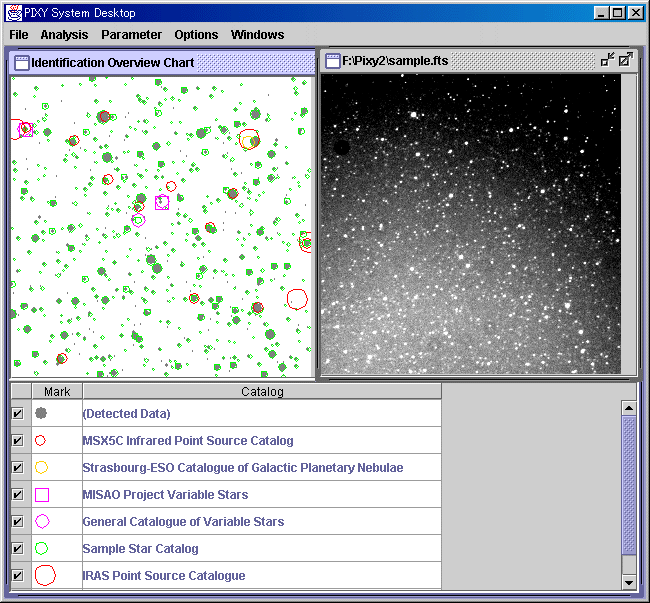Japanese version Home Page Updated on September 19, 2001
September 19, 2001Support of cataloguesMISAO Project Announce Mail (September 19, 2001) Hello. I am Seiichi Yoshida working on the MISAO project. The latest version of the PIXY System 2, 2001 September 18 version, is released. In this version, many astronomical catalogs are supported. The latest PIXY System 2 can read 27 sorts of catalog files, and the 130 sorts of celestial objects are supported. The "Supported Catalogues" page summarizes the supported catalogs. http://www.aerith.net/misao/pixy/catalog.html Most of the catalogs are available via WWW. This page has links to those catalog files so that people can download them. Various kinds of catalogs are supported, not only star catalogs such as the GSC 1.1, USNO-A2.0, Tycho-2 Catalogue, etc., but also variable stars like the GCVS and MisV, clusters and nebulae like the NGC 2000.0, infrared objects like the IRAS and MSX5C, and so on. The PIXY System 2 uses a star catalog to examine an image at first. But after once examined, the system can identify detected stars with any type of catalog. So the user can research what kinds of stars in the image field comprehensively. Especially, the following file: Taichi Kato's Catalog of Variable Stars, etc., for VSNET compiled mainly by Taichi Kato, Kyoto University, is a useful catalog that records many remarkable objects. Most of the recent new variable stars reported from observers in the world are also covered by the file. New variable stars discovered by amateurs, Kesao Takamizawa, Katsumi Haseda, Klaus Bernhard, Akira Takao, etc., and of course the MISAO Project new variable stars are also recorded in that file. Those stars need magnitude observations in order to reveal the characters. Besides variable stars, there are many objects in that file, that need observations. The PIXY System 2 has a function to register those catalogs into the database and construct a catalog database. In the MISAO Project activity, all supported catalogs, except for star catalogs such as GSC 1.1, USNO-A2.0, Tycho-2 Catalogue, etc., are registered into the database so that we can identify detected stars from the offered images with the stars in the database and accumulate the magnitude data. The total number of stars registered in the database is about 1.3 million now. The magnitude observations of them will be gradually reported to the public. A sample image and the examination result XML file, after identified with the catalog database, are enclosed in the PIXY System 2 package. When you open the sample XML file in the "Review" mode and create the identification overview chart, you will see there are two sorts of variable stars, GCVS and MisV, and two sorts of infrared objects, IRAS and MSX5C, in the image field. There are some stars detected from the image, for each sort. And there is a planetary nebula PN G010.4+04.5 is in the field too, but too faint to be detected. 
As this sample shows, there are some, or some dozens of, remarkable objects in an amateur's image field in common. You can research what objects exist in your image using the PIXY System 2. If you offer your image to the MISAO Project, we will measure the magnitude of them and report to the public, then the data will contribute to astronomy. Taichi Kato, and so many people kindly gave me information and advice on catalogs. I appreciate to everyone.
P.S. http://www.aerith.net/misao/ -- Seiichi Yoshida comet@aerith.net http://www.aerith.net/ |
